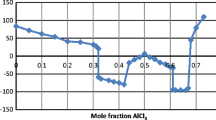Abstract
The temperature-dependent heat capacity of vysotskite, PdS, has been determined for the first time by adiabatic, relaxation, and differential scanning calorimetry in a wide temperature range and standard thermodynamic functions of PdS have been calculated. The 298.15-K values thus obtained are  = 43.65 ± 0.09 J/(mol K), S° = 51.98 ± 0.10 J/(mol K), Н°(298.15 К) − Н°(0) = 8.03 ± 0.02 kJ/mol, and Ф° = 25.03 ± 0.05 J/(mol K). Using the present results and data in the literature, we obtained ΔfH°(PdS, 298.15 K) = –74.0 ± 1.0 kJ/mol and ΔfG°(PdS, 298.15 K) = –68.7 ± 1.0 kJ/mol.
= 43.65 ± 0.09 J/(mol K), S° = 51.98 ± 0.10 J/(mol K), Н°(298.15 К) − Н°(0) = 8.03 ± 0.02 kJ/mol, and Ф° = 25.03 ± 0.05 J/(mol K). Using the present results and data in the literature, we obtained ΔfH°(PdS, 298.15 K) = –74.0 ± 1.0 kJ/mol and ΔfG°(PdS, 298.15 K) = –68.7 ± 1.0 kJ/mol.

Similar content being viewed by others
REFERENCES
Gaskell, T.F., The structure of braggite and palladium sulphide, Z. Kristallogr., 1937, vol. 96, pp. 203–213.
Gronvold, F. and Rost, E., On the sulfides, selenides and tellurides of palladium, Acta Chem. Scand., 1956, vol. 10, pp. 1620–1634.
Brese, N.E., Squattrto, P.J., and Ibers, J.A., Reinvestigation of the structure of PdS, Acta Crystallogr., Sect. C: Cryst. Struct. Commun., 1985, vol. 41, pp. 1829–1830.
Okamoto, H., Pd–S (palladium–sulfur), J. Phase Equilib., 1992, vol. 13, no. 1, pp. 106–107.
Hummel, W., Berner, U., Curti, E., Pearson, F.J., and Thoenen, T., Nagra/PSI chemical thermodynamic database 01/01, Nagra Technical Report NTB 02-16, Wettingen, 2002, pp. 248–249.
Liu-Cheng Chen, Bin-Bin Jiang, Hao Yu, Hong-Jie Pang, Lei Su, Xun Shi, Li-Dong Chen, and Xiao-Jia Chen, Thermoelectric properties of polycrystalline palladium sulfide, RSC Adv., 2018, vol. 8, pp. 13154–13158. https://doi.org/10.1039/c8ra01613e
Kullerud, G., Experimental techniques in dry sulfide research. Research Techniques for High Temperature and High Pressure, Ulmer, G.C., Ed., New York, 1971, pp. 288–315.
NIST. Atomic Weights and Isotopic Compositions. http://www.physics.nist.gov/PhysRefData/Compositions.
Malyshev, V.M., Mil’ner, G.A., Sorkin, E.L., and Shibakin, V.F., Automatic low temperature calorimeter, Prib. Tekh. Eksp., 1985, vol. 6, pp. 195–197.
Lashley, J.C., Hundley, M.F., Migliori, A., Sarrao, J.L., Pagliuso, P.G., Darling, T.W., Jaime, M., Cooley, J.C., Hults, W.L., Morales, L., Thoma, D.J., Smith, J.L., Boerio-Goates, J., Woodfield, B.F., Stewart, G.R., Fisher, R.A., and Phillips, N.E., Critical examination of heat capacity measurements made on a Quantum Design physical property measurement system, Cryogenics, 2003, vol. 43, pp. 369–378.
Gurevich, V.M. and Khlyustov, V.G., Calorimeter for determining low-temperature heat capacity of minerals. Heat capacity of quartz from 9 to 300 K, Geokhimiya, 1979, no. 6, pp. 829–839.
Sassani, D.C. and Shock, E.L., Solubility and transport of platinum-group elements in supercritical fluids: summary and estimates of thermodynamic properties for ruthenium, rhodium, palladium, and platinum solids, aqueous ions and complexes to 1000°C and 5 kbar, Geochim. Cosmochim. Acta, 1998, vol. 62, pp. 2643–2671.
Karzhavin, V.K., Sulfides, selenides, and tellurides of platinum and palladium: estimation of thermodynamic properties, Geochem. Int., 2007, vol. 45, no. 9, pp. 931–937.
Quan Shi., Snow, C.L., Boerio-Goates, J., Woodfield, B.F., Accurate heat capacity measurements on powdered samples using a Quantum Design physical property measurement system, J. Chem. Thermodyn., 2010, vol. 42, pp. 1107–1115. https://doi.org/10.1016/j.jct.2010.04.008
Medvedev, V.A., Bergman, G.A., et al., Termicheskie konstanty veshchestv (Thermal Constants of Substances), Glushko, V.P., Ed., Moscow: VINITI, 1972, issue VI, pp. 322–323.
Niwa, K., Yokokawa, T., and Isoya, T., Equilibria in the PdS–H2–Pd4S–H2S and Pd4S–H2–Pd–H2S systems, Bull. Chem. Soc. Jpn., 1962, vol. 35, pp. 1543–1545.
Biltz, W. and Laar, J., Tensionsanalyse der hoheren Palladiumsulfide, Z. Anorg. Chem., 1936, vol. 228, pp. 257–267.
Pankratz, L.B., Thermodynamic Properties of Elements and Oxides, Washington, D.C.: U.S. Dept. Interior, Bur. Mines, 1982, no. 672.
Naumov, G.B., Ryzhenko, B.N., and Khodakovsky, I.L., Spravochnik termodinamicheskikh velichin (A Handbook of Thermodynamic Quantities), Moscow: Atomizdat, 1971, p. 240.
Cox, J.D., Wagman, D.D., and Medvedev, V.A., CODATA Key Values for Thermodynamics, New York: Hemisphere, 1989.
ACKNOWLEDGMENTS
This research became possible by virtue of the thermodynamic database created by Dr. Sci. (Chem.), Prof. I.L. Khodakovskii (1941–2012).
In this work, we used equipment at the Shared Physical Characterization Facilities Center, Kurnakov Institute of General and Inorganic Chemistry, Russian Academy of Sciences.
Funding
The study of the heat capacity of PdS in this work was supported by the Russian Federation Ministry of Science and Higher Education (state research target for the Kurnakov Institute of General and Inorganic Chemistry, Russian Academy of Sciences, basic research).
Author information
Authors and Affiliations
Corresponding author
Additional information
Translated by O. Tsarev
Rights and permissions
About this article
Cite this article
Polotnyanko, N.A., Tyurin, A.V., Chareev, D.A. et al. Heat Capacity and Thermodynamic Functions of PdS. Inorg Mater 56, 683–689 (2020). https://doi.org/10.1134/S0020168520070134
Received:
Revised:
Accepted:
Published:
Issue Date:
DOI: https://doi.org/10.1134/S0020168520070134




